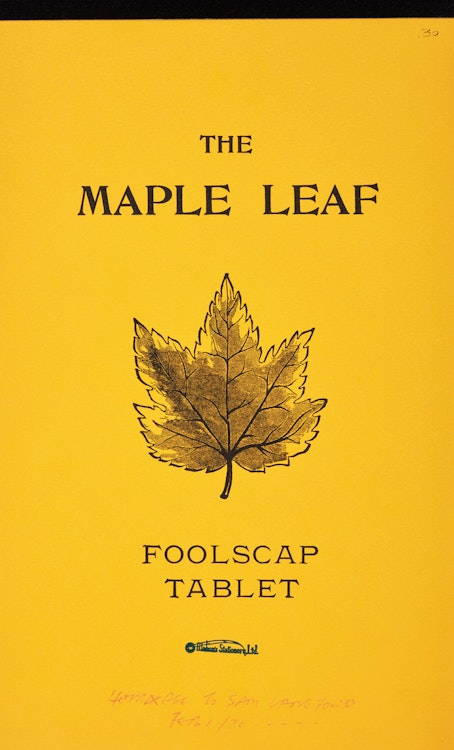Homage to Sam Langford by Gregory Richard Curnoe

Greg Curnoe
Homage to Sam Langford
ten lithographs on arches paper
Ten lithographs: one three-colour lithograph, with hand-stamped fourth colour, on Arches paper (cover page); two seven-colour, five six-colour, and two five-colour lithographs on Arches paper
each lithograph with a stamped signature, numbered “15/50” and inscribed “NS109” through “NS112” on the reverse; presented within “The Maple Leaf Foolscap Tablet” cover which is titled and dated “Feb 1/70” lower centre; unframed
Collaborating Printer: Robert Rogers
12.75 x 7.75 ins ( 32.4 x 19.7 cms ) ( sheet )
Auction Estimate: $1,500.00 - $2,000.00
Price Realized $1,920.00
Sale date: November 7th 2023
NSCAD Lithography Workshop, NSCAD University, Halifax
Jayne Wark, "Conceptual Lithography at the Nova Scotia College of Art and Design", Journal of Canadian Art History, 2009, page 64
Garry Neill Kennedy, “The Last Art College: Nova Scotia College of Art and Design, 1968-1978”, Art Gallery of Nova Scotia, Halifax/The MIT Press, Cambridge, Massachusetts & London, England, 2012, page 40 ; illustrated page 40
Share this item with your friends
Gregory Richard Curnoe
(1936 - 1992)
Born in London, Ontario in 1936, Greg Curnoe was a fervent regionalist visual artist and musician who championed the distinct voice of Canadian locales and London, Ontario, specifically. He attended Beal Technical School (1954-1956) and the Doon School of Art (1956) before attending the Ontario College of Art (1957-1960) then returned to London in 1960.
While still attending Beal Tech he became interested in Dada art and joined the Société Pour L’Etude Du Movement Dada since he himself became dedicated to attacking existing standards of the establishment bound by international styles of art. Taking the opposite pole, Curnoe freed himself from this concern by choosing his subjects immediately around him and rejoicing in a people’s art he encountered in everyday personal experiences.
One can find in his work the elements of constructivism, op art, pop art, dadaism and comic-strip-like marriage of words and pictures, a facet of art which has been his keen interest from his earliest years (his childhood ambition was to be a cartoonist). Curnoe’s work is drawn together by colours ranging from a brilliant carnival-like intensity to softer blends of browns, oranges, pinks, greens, etc.
In an article on Curnoe’s work in Saturday Night, Barry Hale in 1970 gave this description, “Curnoe’s paintings are as immediate in their impact as superlative, blown-up comic books; they are figurative, but not ‘realistic’ - the outlines (in general) are hard edged, there is no modelling, and large, brilliant colour areas collide and vibrate to achieve a hotly overwhelming whole. Like comics, they are printed all over the works, in various manners – words as labels, or self-contained statements like cartoon-balloons; they may surround the picture frame and lead off the right edge (like the narrative print of a cartoon strip), or simply exist in conjunction as a kind of concrete poetry – so , as well as their hot impact, Curnoe’s paintings have a McLuhanesque cool, they must be read, with all the self-involvement that reading implies.”
In addition to his painting, Curnoe was involved in many other fields, including nihilist politics, writing, film making, pop music and non music. In 1961 he began publishing the magazine “Region” with friends, as his commitment to regionalism intensified. They also opened the Region Gallery. He co-founded the Association for the Documentation of Neglected Aspects of Culture in Canada and co-founded the Canadian Artist’s Representation (a national association of Canadian artists growing in stature); the Nihilist Party of London, a good natured group of hecklers of establishment parties (all members with equal say, no leader). His work was first recognized by Ronald Bloore in 1961 when Bloore was a juror of a show and awarded Curnoe a prize.
Curnoe went on to represent Canada at the Venice Biennale in 1976 and had a retrospective at the Montreal Museum of Fine Arts in 1981, which then travelled across Canada. Though the artist’s work has influences of Abstract Expressionism, Pop Art and even musicality, Curnoe rooted his practice in the regional visual language of his native London and greater Canada. He is represented in the National Gallery of Canada, Vancouver Art Gallery, the Art Gallery of Ontario and the Montreal Museum of Fine Arts.
Sources: "A Dictionary of Canadian Artists, Volume I: A-F", compiled by Colin S. MacDonald, Canadian Paperbacks Publishing Ltd, Ottawa, 1977

